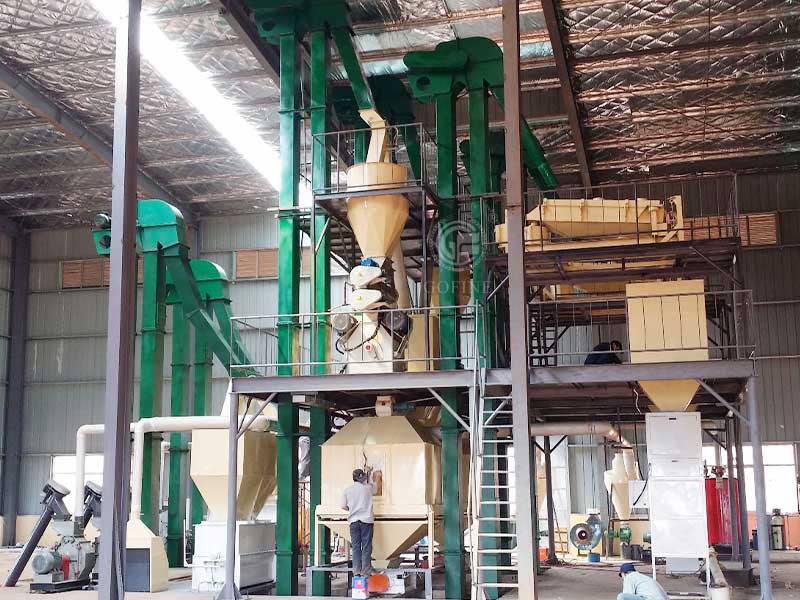Exploring the Animal Feed Production Line
Exploring the Animal Feed Production Line
In the prosperous development of agriculture and animal husbandry, the feed production line is like a mysterious factory, converting various raw materials into nutritious and high-quality feed. Let us unveil its mystery and gain a deeper understanding of this complex and exquisite production process.

1. Convergence and screening of raw materials
The starting point of the animal feed production line is the convergence of various raw materials. A wide variety of raw materials such as corn, soybeans, wheat bran, fish meal, bone meal, etc. come from all directions and enter the spacious raw material warehouse. Before entering the warehouse, they must undergo strict screening and inspection to ensure that there are no impurities, mold or ingredients that do not meet quality standards.
For example, the particle size and moisture content of corn must meet specific requirements, and the protein content of soybeans must meet the specified standards. Only raw materials that have passed these strict screening are eligible to enter the subsequent production links.
2. Fine grinding and mixing
The screened raw materials are transported to the grinding equipment, where they are crushed into a fine and uniform powder. The particle size of the crushing is precisely adjusted according to the needs of different animals and feed formulas. Subsequently, these powdered raw materials enter the batching and mixing system. Advanced batching equipment can accurately measure and put various raw materials according to the preset formula to ensure that the proportion of each ingredient is accurate. Under the action of the powerful stirring device, the raw materials are fully mixed to form a uniform mixture.
To give you a more intuitive understanding, imagine making a delicate cake. The proportion and degree of mixing of various raw materials directly affect the final taste and quality. The same is true for feed production.
3. Innovative granulation and puffing process
The mixed materials then enter the granulation or puffing stage. The Feed pellet mill squeezes the material into granules, which increases the stability and palatability of the feed and facilitates animal feeding and digestion. The puffing process causes the feed to undergo physical and chemical changes under high temperature and high pressure, further improving its nutritional value and digestion and absorption rate.
Taking pet feed as an example, the puffed pellet feed has a better taste and shape, which can attract the appetite of pets and provide them with sufficient nutrition.

4. Strict quality inspection and control
Quality inspection is always present throughout the production process. From the detection of raw materials to sampling analysis during the production process, to the comprehensive testing of finished feed, every link cannot be missed.
The testing items cover multiple aspects such as nutrients, microbial indicators, and heavy metal content. Only feeds that meet national standards and industry specifications can be allowed to enter the market.
5. Efficient automation and intelligence
Modern feed production lines are highly automated and intelligent. The computer control system can monitor the production process in real time and automatically adjust parameters to ensure stable production operation. At the same time, the intelligent fault diagnosis system can detect and solve potential problems in a timely manner, greatly reducing the risk of production interruption.
For example, when the operating parameters of a certain equipment are abnormal, the system will immediately issue an alarm and automatically take corresponding measures to ensure the continuous operation of the production line.
6. Environmental protection and sustainable development
With the continuous improvement of environmental awareness, feed production lines are also actively practicing the concept of sustainable development. By adopting energy-saving equipment and optimizing production processes, energy consumption and waste emissions can be reduced. At the same time, the by-products and waste generated in the production process are reasonably recycled to maximize the utilization of resources.

In short, the animal feed production line is a complex system that integrates technology, technology and quality control. It continues to innovate and develop, providing high-quality feed for animals, and making important contributions to the prosperity of animal husbandry and food safety. I believe that in the future, the animal feed production line will continue to move forward on the road of intelligence and environmental protection, creating a better future for agriculture and animal husbandry for us.
Prev: Chicken Feed Pellet Mill-A Good Helper for Chicken Farms Next: Gofine feed mixer helps breeding reach a new peak




